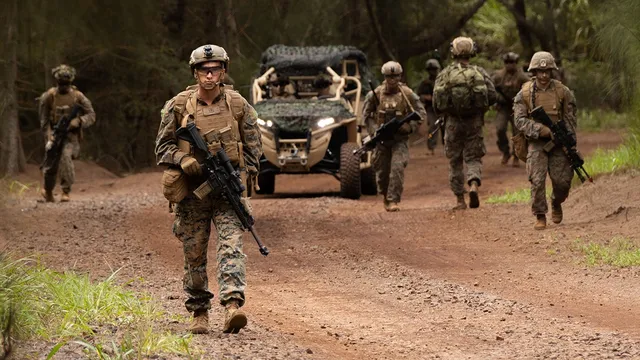
Trump deploys 700 Marines to quell unrest in Los Angeles
2025-06-12 18:21- The Trump administration announced the deployment of approximately 700 Marines to aid the National Guard in Los Angeles amid rising protests over immigration enforcement.
- California state officials, including Governor Gavin Newsom, filed a lawsuit against the federal government regarding the legality of this military activation.
- This unprecedented action reflects larger concerns about the militarization of domestic law enforcement and the implications of deploying active-duty troops in civilian areas.
Express your sentiment!
Insights
In response to ongoing unrest and protests against immigration enforcement, the U.S. military has mobilized approximately 700 Marines to Los Angeles, California. This deployment comes as part of a broader strategy to partner these forces with the National Guard, who were previously deployed to aid in protecting federal properties and personnel against potential violence. The integration of these active-duty Marines into the region aims to reinforce federal presence during a time of civil discord, particularly in light of organized protests triggered by immigration raids. These developments highlight tensions surrounding federal law enforcement actions and the role of the military in domestic situations. The U.S. Northern Command confirmed that the Marines are part of Task Force 51, which also includes around 2,100 National Guard personnel. The decision to deploy these troops was announced after California Governor Gavin Newsom filed a lawsuit against the federal government, asserting that the deployment violated state authority and the 10th Amendment. Critics have raised concerns over the potential use of military force against civilians in the context of these protests, indicating a possible overreach of presidential powers. Trump had referenced these protests as potential insurrections, declaring that actions may have been necessary to prevent further unrest. The circumstances surrounding this deployment are particularly sensitive, as it raises questions concerning the Posse Comitatus Act, which limits the military's role in domestic law enforcement. Officials at the Pentagon are currently drafting rules governing the conduct of Marines in this domestic assignment, specifying protocols for engagement and emphasizing de-escalation through training methods. Troops will be armed but will not utilize tear gas, highlighting the balance between enforcement and restraint during this delicate situation. Calls for appropriate oversight of military involvement underscore the potential risks of deploying active-duty forces in civilian settings. Various officials have also voiced concerns about the legality and morality of utilizing military troops to manage civil disturbances, reflecting broader cultural apprehensions about the militarization of domestic issues. While the deployment aims to stabilize the environment in Los Angeles, the long-term implications of using military personnel for policing functions remain a topic of heated debate among lawmakers and citizens alike.
Contexts
The history of military deployment within U.S. cities reflects the evolving relationship between civilian authority and military presence in domestic affairs. This dynamic began forming during the colonial period and has been shaped by various socio-political contexts throughout American history. Early instances of troop deployments in cities were often in response to civil unrest, issues surrounding governance, or external threats. For example, the use of troops to quash uprisings like the Whiskey Rebellion in 1794 demonstrated the federal government's willingness to employ military force to maintain order and assert authority over rebellious elements within its own borders. The 20th century saw further military involvement in urban environments, particularly during times of war or civil rights unrest. For instance, during the Great Depression, military forces were sometimes called upon to manage social disorder arising from economic hardship. Similarly, in the 1960s, ongoing civil rights protests and riots prompted deployments of National Guard units to restore peace in cities like Detroit and Los Angeles, highlighting the military's role in addressing social issues and preserving public order. The urban riots of that era raised significant questions about the militarization of policing and the appropriateness of deploying military personnel in domestic contexts. The aftermath of the September 11 attacks in 2001 marked another significant turning point in military deployment practices within American cities. The increased threat of terrorism led to a more pronounced military presence through initiatives like the Department of Homeland Security, which works in partnership with local law enforcement agencies. This period also witnessed the rise of joint training exercises and the provision of military equipment to civilian law enforcement, blending military practices with police duties under the guise of enhancing security and preparedness. However, the lines between military and civilian roles have since blurred, raising concerns regarding civil liberties and the potential for excessive force. Most recently, the deployment of National Guard and military units in cities in response to social movements and protests has reignited debates about the appropriateness and consequences of military presence in domestic situations. Events surrounding the protests following the death of George Floyd in 2020 exemplified the tensions that arise from militarized responses to civil unrest. These deployments, often justified under the banner of maintaining law and order, have sparked conversations about the implications of military action on civil rights, community relations, and public trust in government. Overall, the history of military deployment within U.S. cities is marked by dichotomies between maintaining order and protecting democratic values, reflecting the ongoing struggle to balance security needs with the rights of citizens.